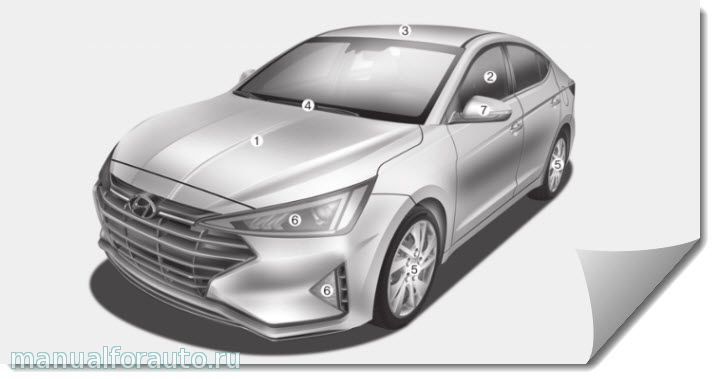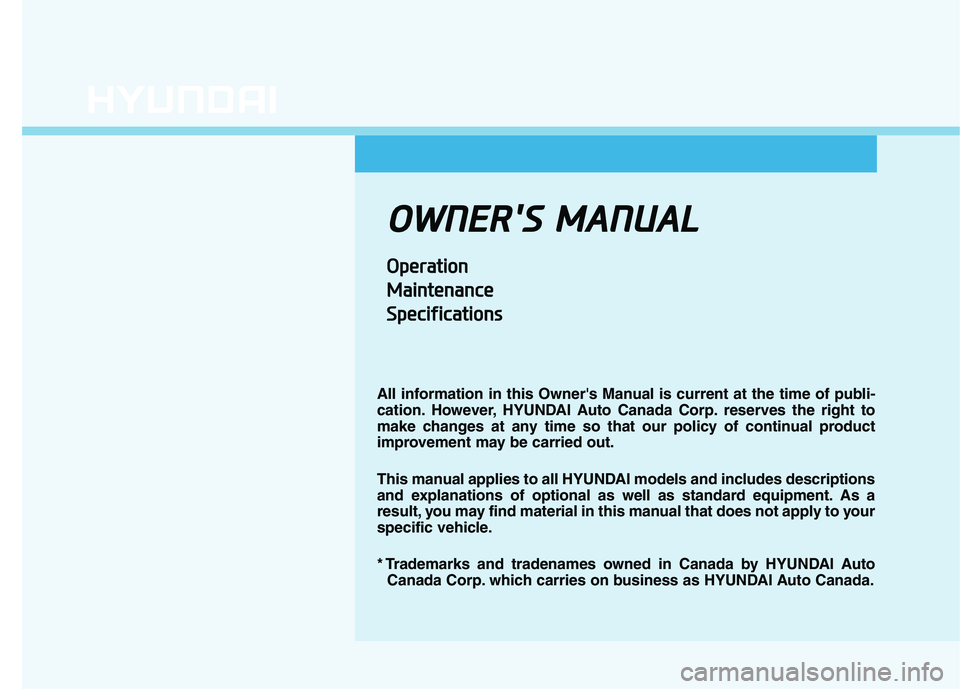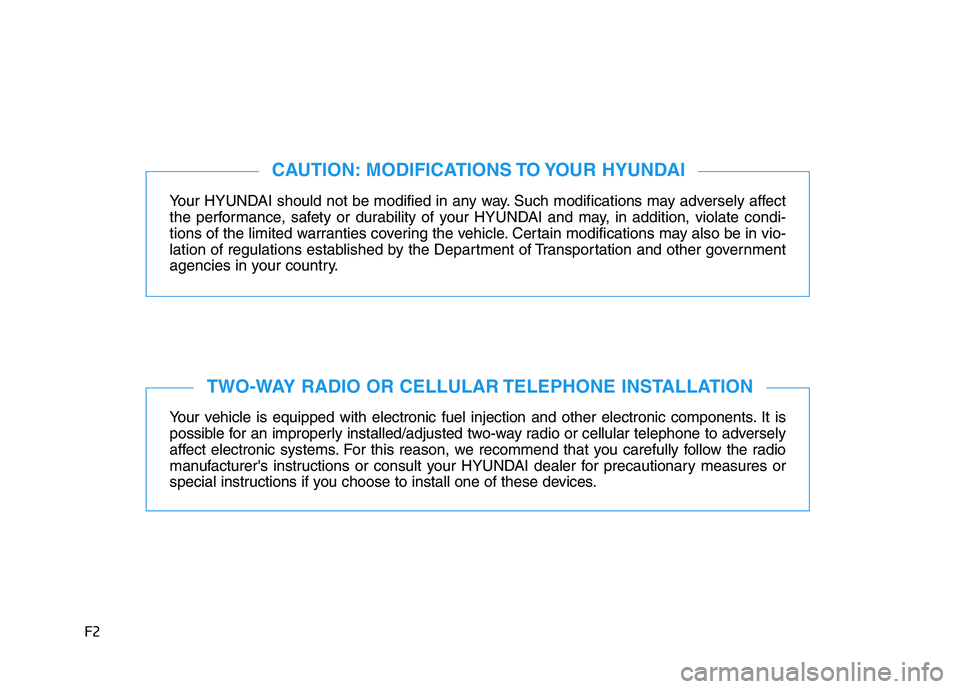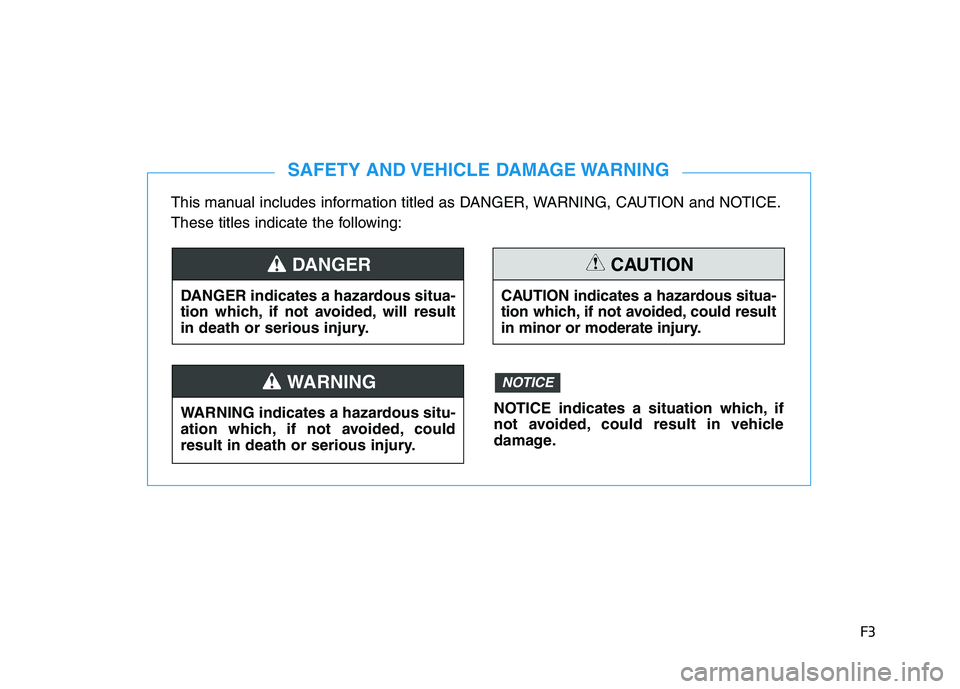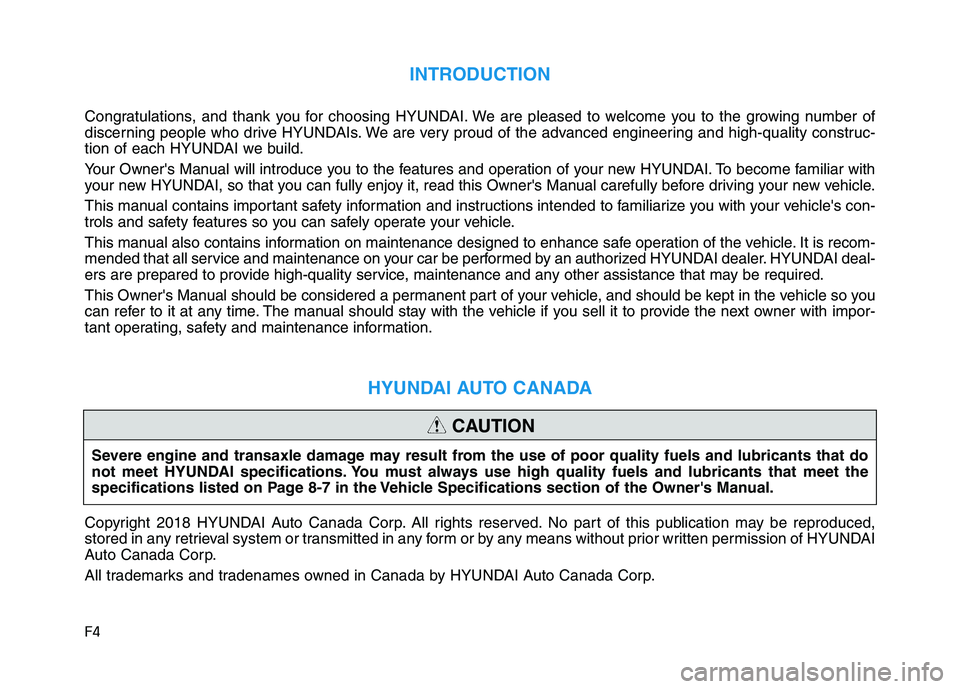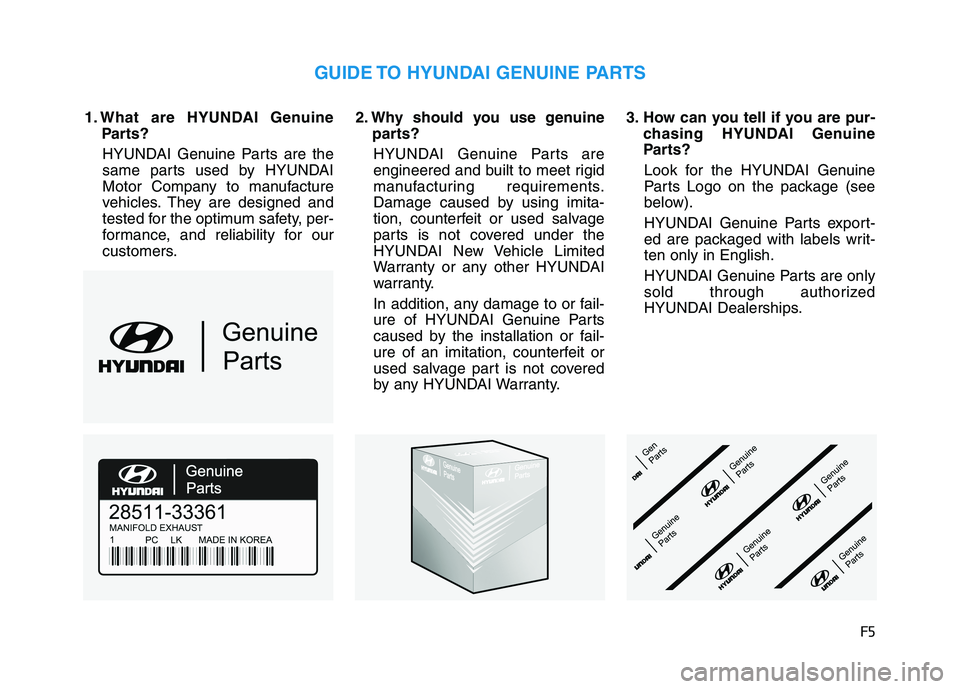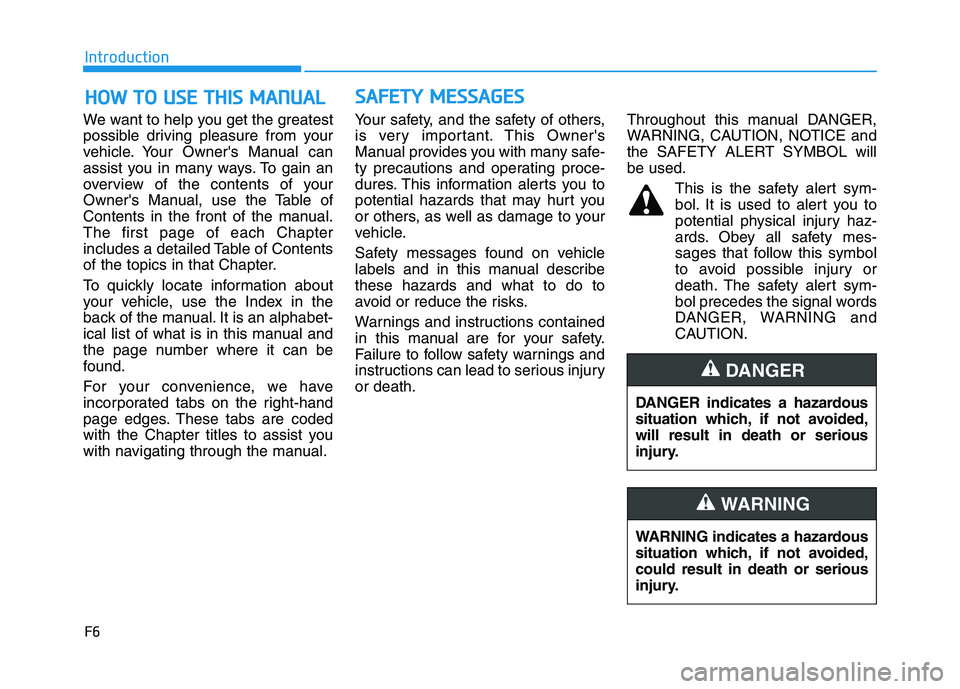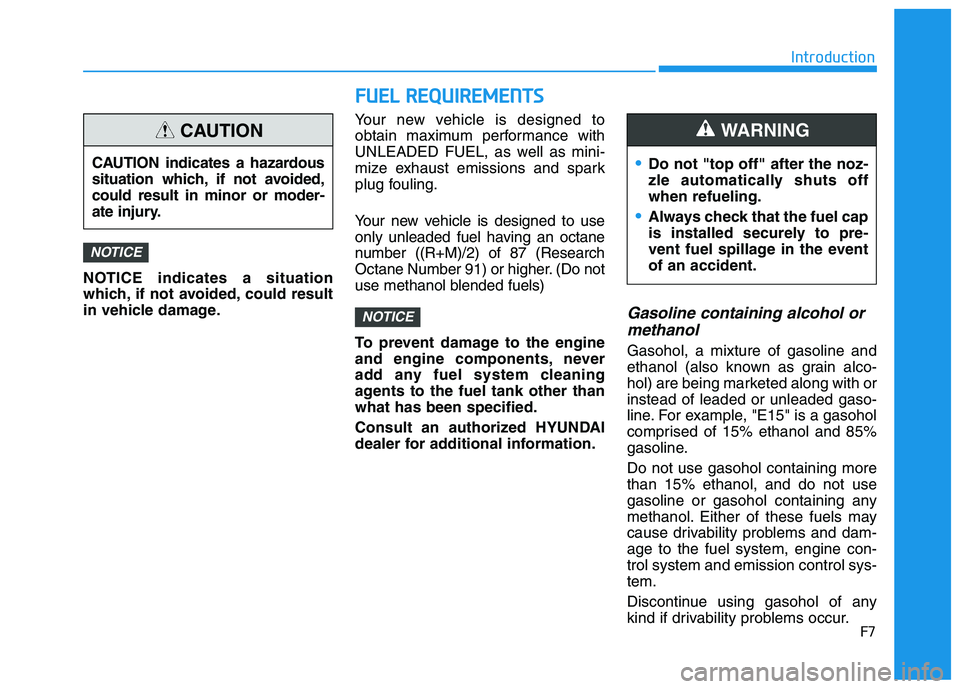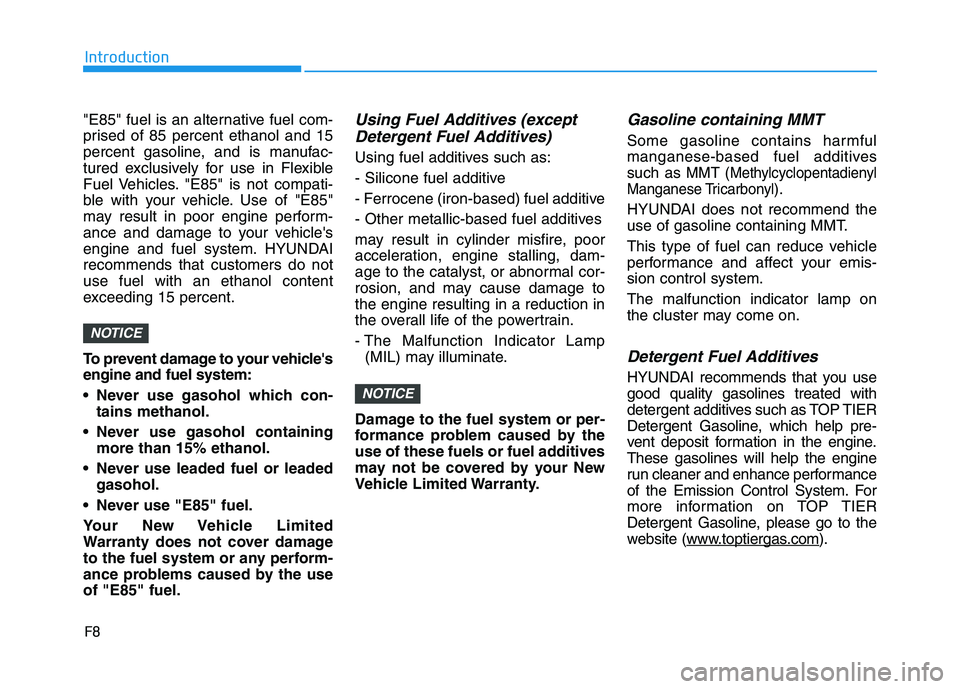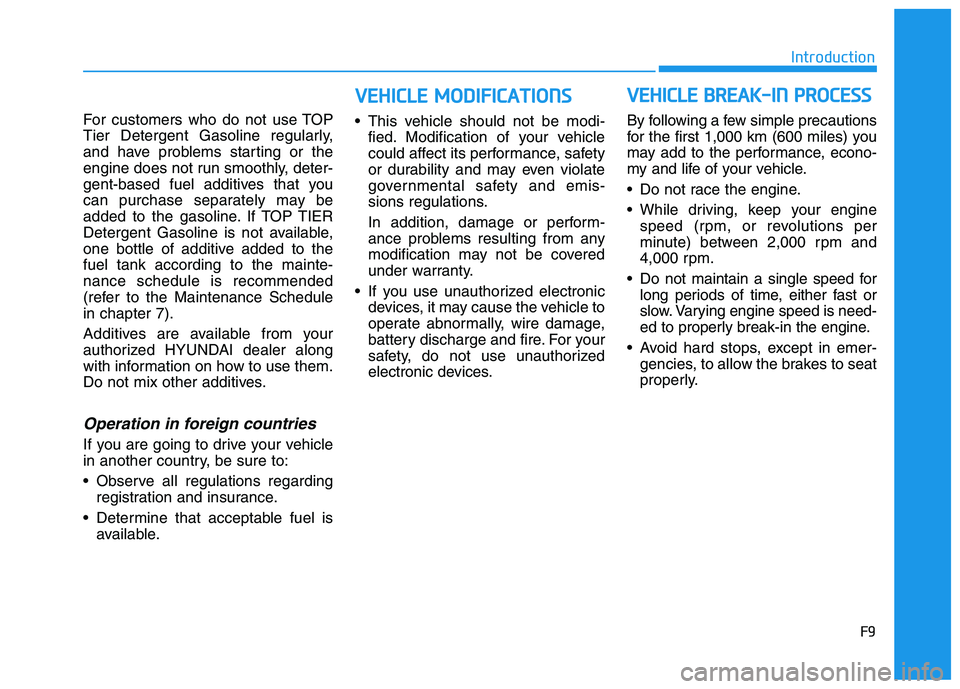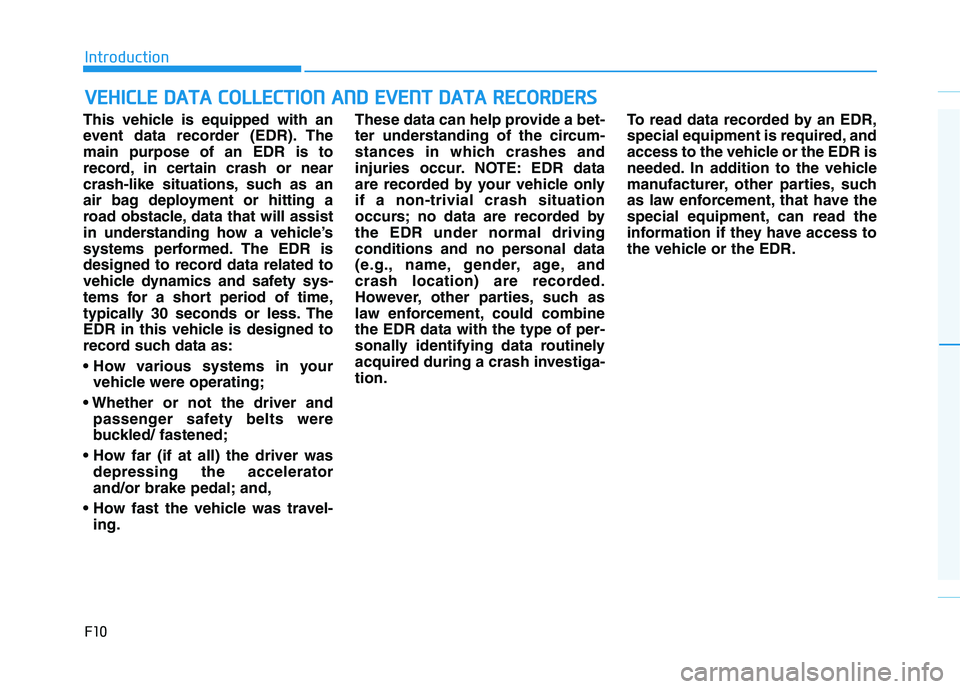- Manuals
- Brands
- Hyundai Manuals
- Automobile
- ELANTRA 2019
Manuals and User Guides for Hyundai ELANTRA 2019. We have 2 Hyundai ELANTRA 2019 manuals available for free PDF download: Owner’s Manual, Quick Reference Manual
Hyundai ELANTRA 2019 Owner’s Manual (568 pages)
Brand: Hyundai
|
Category: Automobile
|
Size: 6.31 MB
Table of Contents
-
Table of Contents
11
-
Your Vehicle at a Glance
12
-
Safety System of Your Vehicle
21
-
-
Convenient Features of Your Vehicle
79
-
Remote Key
82
-
Smart Key
87
-
Immobilizer System
89
-
Operating Door Locks from Outside the Vehicle
89
-
Operating Door Locks from Inside the Vehicle
91
-
Auto Door Lock/Unlock Features
93
-
Child-Protector Rear Door Locks
93
-
Safe Exit Assist (SEA) System
94
-
Driver Position Memory System
97
-
Driver Position Memory System Reset
97
-
Recalling Memory Positions
97
-
Easy Access Function
98
-
Electric Power Steering (EPS)
99
-
Heated Steering Wheel
100
-
Tilt Steering / Telescope Steering
100
-
Horn
101
-
Inside Rearview Mirror
102
-
Outside Rearview Mirror
103
-
Reverse Parking Aid Function
106
-
Power Windows
107
-
Sunroof Opening and Closing
113
-
Sliding the Sunroof
113
-
Tilting the Sunroof
114
-
Sunshade
115
-
Resetting the Sunroof
115
-
Sunroof Open Warning
116
-
Hood
117
-
Trunk
118
-
Smart Trunk
120
-
Fuel Filler Door
123
-
Instrument Cluster Control
128
-
Gauges and Meters
129
-
Transmission Shift Indicator
132
-
Warning and Indicator Lights
134
-
LCD Display Messages
145
-
-
LCD Display (for Supervision Cluster)
145
-
LCD Display Control
151
-
LCD Display Modes
152
-
-
Trip Computer
163
-
Conventional Cluster
163
-
Supervision Cluster
167
-
-
Exterior Lights
171
-
Welcome System
179
-
Interior Lights
180
-
Windshield Wipers
183
-
Windshield Washers
185
-
Rear View Monitor
186
-
Parking Distance Warning (Reverse) System
187
-
Parking Distance Warning (Reverse/Forward)
187
-
System
187
-
Heating and Air Conditioning
195
-
System Operation
200
-
System Maintenance
202
-
Automatic Heating and Air Conditioning
205
-
Manual Heating and Air Conditioning
206
-
System Operation
212
-
System Maintenance
214
-
Auto Defogging System
218
-
Automatic Climate Control System
218
-
Defogging Logic
218
-
Manual Climate Control System
218
-
Defroster
220
-
Automatic Ventilation
221
-
Clean Air
221
-
Sunroof Inside Air Recirculation
221
-
Center Console Storage
222
-
Sliding Armrest
222
-
Glove Box
223
-
Sunglass Holder
223
-
Ashtray
224
-
Cup Holder
224
-
Front
224
-
Power Outlet
226
-
Sunvisor
226
-
Cigarette Lighter
228
-
USB Charger
228
-
Wireless Cellular Phone Charging System
229
-
Clock
231
-
Coat Hook
231
-
Floor Mat Anchor(S)
232
-
Luggage Net (Holder)
233
-
-
Multimedia System
234
-
AUX, USB and Ipod ® Port
235
-
Multimedia System
235
-
Antenna
236
-
Steering Wheel Audio Control
237
-
Audio / Video / Navigation System (AVN)
238
-
Bluetooth ® Wireless Technology Hands-Free
238
-
How Vehicle Radio Works
239
-
System Layout — Control Panel
242
-
System Layout — Steering Wheel Remote Control
246
-
Turning the Display on or off
249
-
Turning the System on or off
249
-
Getting to Know the Basic Operations
250
-
Turning on the Radio
251
-
Changing the Radio Mode
253
-
Scanning for Available Radio Stations
253
-
Searching for Radio Stations
253
-
Listening to Saved Radio Stations
254
-
Saving Radio Stations
254
-
Using the Media Player
255
-
Using the USB Mode
256
-
Using the AUX Mode
258
-
Bluetooth
260
-
Connecting Bluetooth Devices
260
-
Using a Bluetooth Audio Device
263
-
Using a Bluetooth Phone
265
-
Usb
272
-
Bluetooth
273
-
CE RED for EU
275
-
Rohs for Taiwan
275
-
NCC for Taiwan
276
-
Fcc
277
-
-
Driving Your Vehicle
278
-
Before Entering the Vehicle
281
-
Before Starting
281
-
Ignition Switch
283
-
Key Ignition Switch
283
-
Engine Start/Stop Button
286
-
Manual Transmission Operation
295
-
Good Driving Practices
297
-
Automatic Transmission Operation
298
-
Parking
302
-
Good Driving Practices
303
-
Dual Clutch Transmission Operation
304
-
LCD Display for Transmission Temperature and Warning Message
306
-
Good Driving Practices
314
-
Parking
314
-
Power Brakes
316
-
Disc Brakes Wear Indicator
317
-
Parking Brake
317
-
Rear Drum Brakes
317
-
Anti-Lock Brake System (ABS)
319
-
Electronic Stability Control (ESC)
321
-
Vehicle Stability Management (VSM)
324
-
Good Braking Practices
325
-
Hill-Start Assist Control (HAC)
325
-
Drive Mode
326
-
Smart Shift on Trip Computer
329
-
System Setting and Activation
331
-
FCA Warning Message and System Control
333
-
FCA Sensor
336
-
System Malfunction
337
-
Limitations of the System
339
-
System Setting and Activation
344
-
FCA Warning Message and System Control
346
-
FCA Sensor (Front Radar/Front Camera)
349
-
System Malfunction
351
-
Limitations of the System
353
-
Blind-Spot Collision Warning (BCW)
359
-
System Description
359
-
System Setting and Activation
360
-
Warning and System Control
361
-
Detecting Sensor
363
-
Limitations of the System
365
-
-
Rear Cross-Traffic Collision Warning (RCCW)
368
-
System Description
368
-
System Setting and Activation
368
-
Warning and System Control
370
-
Detecting Sensor
371
-
Limitations of the System
373
-
-
Lane Keeping Assist (LKA) System
378
-
LKA Operation
378
-
Warning Light and Message
381
-
Limitations of the System
383
-
LKA System Function Change
384
-
-
Driver Attention Warning (DAW) System
385
-
System Setting and Activation
385
-
Resetting the System
386
-
System Standby
387
-
System Malfunction
387
-
Cruise Control Operation
389
-
Smart Cruise Control Switch
394
-
Smart Cruise Control Speed
395
-
Smart Cruise Control Vehicle-To-Vehicle Distance
400
-
Sensor to Detect Distance to the Vehicle Ahead
402
-
To Adjust the Sensitivity of Smart Cruise Control
404
-
To Convert to Cruise Control Mode
405
-
Limitations of the System
405
-
Hazardous Driving Conditions
410
-
Rocking the Vehicle
410
-
Smooth Cornering
411
-
Driving at Night
411
-
Driving in the Rain
411
-
Driving in Flooded Areas
412
-
Highway Driving
412
-
-
Winter Driving
413
-
Snow or Icy Conditions
413
-
Winter Precautions
415
-
If You Decide to Pull a Trailer
418
-
Trailer Towing Equipment
421
-
Driving with a Trailer
422
-
Maintenance When Towing a Trailer
425
-
-
Vehicle Weight
426
-
Overloading
426
-
-
-
What to Do in an Emergency
427
-
If the Engine Stalls at a Crossroad or Crossing
428
-
If the Engine Stalls While Driving
428
-
If the Engine Doesn’t Turn over or Turns over Slowly
429
-
If You Have a Flat Tire While Driving
429
-
If the Engine Turns over Normally but Doesn’t Start
430
-
Jump Starting
431
-
Check Tire Pressure
434
-
Tire Pressure Monitoring System
435
-
Low Tire Pressure Position and Tire Pressure Telltale
436
-
Low Tire Pressure Telltale
436
-
TPMS (Tire Pressure Monitoring System) Malfunction Indicator
437
-
Changing a Tire with TPMS
438
-
Jack and Tools
440
-
Changing Tires
441
-
Jack Label
446
-
EC Declaration of Conformity for Jack
447
-
Towing Service
448
-
Removable Towing Hook
449
-
Emergency Towing
450
-
Fire Extinguisher
452
-
First Aid Kit
452
-
Tire Pressure Gauge
452
-
Triangle Reflector
452
-
-
Maintenance
453
-
Owner Maintenance Precautions
457
-
Owner’s Responsibility
457
-
Owner Maintenance Schedule
458
-
Maintenance under Severe Usage and Low Mileage Conditions — Gasoline Engine (for Europe)
464
-
Maintenance under Severe Usage and
470
-
Checking the Engine Oil and Filter
476
-
Checking the Engine Coolant Level
477
-
Changing the Engine Coolant
480
-
Brake/Clutch Fluid
481
-
Checking the Brake/Clutch Fluid Level
481
-
Checking the Parking Brake
482
-
Checking the Washer Fluid Level
482
-
Filter Replacement
483
-
Filter Inspection
485
-
Filter Replacement
485
-
Blade Inspection
486
-
Blade Replacement
487
-
For Best Battery Service
490
-
Battery Capacity Label
492
-
Battery Recharging
492
-
Reset Items
493
-
Tire Care
494
-
Recommended Cold Tire Inflation Pressures
495
-
Check Tire Inflation Pressure
496
-
Tire Rotation
496
-
Wheel Alignment and Tire Balance
497
-
Tire Replacement
498
-
Tire Maintenance
499
-
Tire Sidewall Labeling
499
-
Tire Traction
499
-
Wheel Replacement
499
-
Low Aspect Ratio Tires
503
-
Instrument Panel Fuse Replacement
505
-
Engine Compartment Panel Fuse Replacement
506
-
Fuse/Relay Panel Description
508
-
Headlamp, Position Lamp, Turn Signal Lamp and
522
-
High Mounted Stop Lamp Replacement
532
-
Interior Light Bulb Replacement
533
-
License Plate Light Bulb Replacement
533
-
Exterior Care
535
-
Interior Care
539
-
Crankcase Emission Control System
542
-
Evaporative Emission Control System
542
-
Exhaust Emission Control System
543
-
Specifications & Consumer Information
546
-
Index
557
-
Advertisement
Hyundai ELANTRA 2019 Quick Reference Manual (24 pages)
Brand: Hyundai
|
Category: Automobile
|
Size: 10.92 MB
Table of Contents
-
Table of Contents
3
-
Features and Controls
4
-
Child-Protector Rear Door Lock
5
-
Headlights
6
-
Homelink Wireless Control System
8
-
Smart Trunk
8
-
Warning and Indicators
10
-
Multimedia
13
-
AUX, USB and Ipod Port
17
-
Clock Adjustment
17
-
MULTIMEDIA Android Auto
18
-
Radio
18
-
Driving
21
-
Forward Collision-Avoidance Assist (FCA)
21
-
Lane Keeping Assist (LKA)
21
-
Rear View Camera
22
-
Safe Exit Assist (SEA)
22
-
Tire Pressure Monitoring System (TPMS)
23
Advertisement
Related Products
-
Hyundai Elantra 2013
-
Hyundai Elantra 2011
-
Hyundai Elantra 2012
-
Hyundai Elantra 2017
-
Hyundai ELANTRA 2016
-
Hyundai Elantra 2018
-
Hyundai ELANTRA 2020
-
Hyundai ELANTRA TOURING
-
Hyundai ELANTRA GT
-
Hyundai ELANTRA HYBRID
Hyundai Categories
Automobile
Car Receiver
Vacuum Cleaner
Car Video System
Monitor
More Hyundai Manuals
Инструкция по эксплуатации на новую Элантру 6 в кузове AD с 2019 года рестайлинг
Характеристики Элантра 6
Тип привода Передний
Тип кузова Седан
Тип трансмиссии АКПП 6 — МКПП 5
Время разгона 0-100 км/ч, с 11.6
Клиренс (высота дорожного просвета), мм 150
Максимальная скорость, км/ч 195
Габариты кузова (Д x Ш x В), мм 4620 x 1800 x 1450
Колесная база, мм 2700
Минимальный радиус разворота, м 5.3
Ширина передней колеи, мм 1555
Ширина задней колеи, мм 1564
Передний свес 915
Задний свес 1005
Масса, кг 1325
Допустимая полная масса, кг 1800
Объем топливного бака, л 50
Объем багажника, л 458
Расход топлива в городском цикле, л/100 км 9.1
Расход топлива за городом, л/100 км 5.3
Расход топлива в смешанном цикле, л/100 км 6,7
Передняя подвеска Независимая, амортизационная стойка типа МакФерсон
Задняя подвеска Полузависимая, торсионная балка
Передние тормоза Дисковые вентилируемые
Задние тормоза Дисковые
Лампы Хендай Элантра с 2019 года
LED в зависимости от комплектации
Ближний HB3 — LED
Дальний HB3 — LED
Поворотник PY28/8W
Ходовые огни P21/5W — LED
Габариты LED
Задние фары
Габариты W5W — LED
габариты / стоп сигнал PY28/8W — LED
Поворотники PY27W
Задний ход P21W
верхний стоп сигнал W21W
номерной знак W5W
Руководство Хендай Элантра
Manufacturer: HYUNDAI, Model Year: 2019,
Model line: ELANTRA SPORT,
Model: HYUNDAI ELANTRA SPORT 2019
Pages: 534, PDF Size: 51.51 MB
Trending: engine, Turbo, roof, reset, charging, maintenance, dashboard
Page 1 of 534
Page 2 of 534
Page 3 of 534
Page 4 of 534
Page 5 of 534
Page 6 of 534
Page 7 of 534
Page 8 of 534
Page 9 of 534
Page 10 of 534
- Load next 10 pages
Trending: phone, sensor, Turbo, maintenance, ESP, lock, light
View, print and download for free: HYUNDAI ELANTRA SPORT 2019 Owners Manual, 534 Pages, PDF Size: 51.51 MB. Search in HYUNDAI ELANTRA SPORT 2019 Owners Manual online. CarManualsOnline.info is the largest online database of car user manuals. HYUNDAI ELANTRA SPORT 2019 Owners Manual PDF Download.
All product names, logos, and brands are property of their respective owners.
Privacy Policy | About Us & Contact
The 2020 Hyundai Elantra is a small car with a stylish exterior, modern technology, and a comfortable interior. The Elantra stands out on the road because of its smooth lines and modern look. It comes in different trim levels, each with a different set of features to suit different tastes and needs.
Hyundai’s signature spiraling grille is on the outside of the Elantra, along with sleek headlights and LED daytime running lights. The design as a whole is efficient and looks good. The cabin is roomy and well-equipped on the inside, and it can fit up to five people. High-quality materials and careful attention to detail make a place look elegant and feel comfy.
The Elantra has a number of technological features. It comes with a touchscreen entertainment system that works with Apple CarPlay, Android Auto, and Bluetooth to make it easy to connect your phone.
There may be a luxury audio system, a navigation system, and wireless charging as options. Safety features, like forward collision warning, automatic emergency braking, lane-keeping assist, and blind-spot tracking, are also a high priority. There are different engine choices for the Elantra when it comes to speed. The base model usually has a 2.0-liter four-cylinder engine, which is a good mix of power and gas mileage. In higher trims, you may be able to get a 1.4-liter or 1.6-liter engine that is turbocharged for better speed. You can choose between a manual or automatic gearbox with six speeds or a dual-clutch automatic gearbox with seven speeds for the turbocharged engine.
The 2020 Hyundai Elantra has a well-tuned frame and quick steering that make it easy and comfortable to drive. The EPA estimates that it gets an average of about 35 mpg combined, which is good.
Overall, the Hyundai Elantra 2020 is a stylish compact car that is well-equipped and easy to drive. It has a modern look, the latest technology, and many safety measures to meet the needs of drivers today.
Where Are the Air Bags?
Driver’s and passenger’s front airbags
Your vehicle is equipped with an Advanced Supplemental Restraint System (SRS) and lap/shoulder belts at both the driver and passenger seating positions. The SRS consists of airbags which are located in the center of the steering wheel, in the driver’s side lower crash pad below the steering wheel column, and in the passenger’s side front panel pad above the glove box. The airbags are labeled with the letters “AIR BAG” embossed on the pad covers. The purpose of the SRS is to provide the vehicle’s driver and front passengers with additional protection than that offered by the seat belt system alone. The SRS uses sensors to gather information about the driver’s and front passenger’s seat belt usage and impact severity. The seat belt buckle sensors determine if the driver’s and front passenger’s seat belts are fastened. These sensors provide the ability to control the SRS deployment based on whether or not the seat belts are fastened, and how severe the impact is. The advanced SRS offers the ability to control airbag inflation within two levels. A first-stage level is provided for moderate-severity impacts. A second stage level is provided for more severe impacts. According to the impact severity, and seat belt usage, the SRS Control Module (SRSCM) controls the air bag inflation. Failure to properly wear seat belts can increase the risk or the severity of injury in an accident.
To reduce the risk of serious injury or death from inflating front airbags, take the following precautions:
- Seat belts must be worn at all times to help keep occupants positioned properly.
- Move your seat as far back as possible from the front airbags, while still maintaining control of the vehicle.
- Never lean against the door or center console.
- Do not allow the front passenger to place their feet or legs on the dashboard.
- No objects (such as crash pad cover, cellular phone holder, cup holder, perfume or stickers) should be placed over or near the airbag modules on the steering wheel, instrument panel, windshield glass, and the front passenger’s panel above the glove box. Such objects could cause harm if the vehicle is in a crash severe enough to cause the airbags to deploy.
- Do not attach any objects on the front windshield and inside mirror
Your vehicle is equipped with a side airbag in each front seat. The purpose of the airbag is to provide the vehicle’s driver and the front passenger with additional protection than that offered by the seat belt alone. The side airbags are designed to deploy during a certain side-impact collision, depending on the crash severity. The side and curtain airbags on both sides of the vehicle may deploy if a rollover or possible rollover is detected. The side airbags are not designed to deploy in all side impact or rollover situations.
WARNING
To reduce the risk of serious injury or death from an inflating side airbag, take the following precautions:
- Seat belts must be worn at all times to help keep occupants positioned properly
- Do not allow passengers to lean their heads or bodies onto doors, put their arms on the doors, stretch their arms out of the window, or place objects between the doors and seats.
- Hold the steering wheel at the 9 o’clock and 3 o’clock positions, to minimize the risk of injuries to your hands and arms.
Do not use any accessory seat covers. This could reduce or prevent the effectiveness of the system. - Do not place any objects over the airbag or between the airbag and yourself. Also, do not attach any objects around the area the airbag inflates such as the door, side door glass, and front and rear pillars.
- Do not place any objects between the door and the seat. They may become dangerous projectiles if the side airbag inflates.
- Do not install any accessories on the side or near the side airbags.
- Do not put any objects between the side airbag label and the seat cushion. It could cause harm if the vehicle is in a crash severe enough to cause the airbags to deploy.
- Do not cause an impact on the doors when the ignition switch is in the ON position or this may cause the side airbags to inflate.
- If the seat or seat cover is damaged, have the vehicle checked and repaired by an authorized HYUNDAI dealer?
Curtain airbags
Curtain airbags are located along both sides of the roof rails above the front and rear doors. They are designed to help protect the heads of the front seat occupants and the rear outboard seat occupants in certain side-impact collisions. The curtain airbags are designed to deploy during certain side-impact collisions, depending on the crash severity. The side and curtain airbags on both sides of the vehicle may deploy if a rollover or possible rollover is detected. The curtain airbags are not designed to deploy in all side impact or rollover situations.
WARNING
To reduce the risk of serious injury or death from inflating curtain airbags, take the following precautions:
- All seat occupants must wear seat belts at all times to help keep occupants positioned properly.
- Properly secure child restraints as far away from the door as possible.
- Do not place any objects over the airbag. Also, do not attach any objects around the area the airbag inflates such as the door, side door glass, front and rear pillar, and roof side rail.
- Do not hang other objects except clothes, especially hard or breakable objects. An accident, it may cause vehicle damage or personal injury.
- Do not allow passengers to lean their heads or bodies onto doors, put their arms on the doors, stretch their arms out of the window, or place objects between the doors and seats.
- Do not open or repair the side curtain airbags.
How Does the Air Bag System Operate?
The SRS consists of the following components:
- Driver’s front airbag module
- Passenger’s front airbag module
- Side airbag modules
- Curtain airbag modules
- Retractor pre-tensioner assemblies
- Airbag warning light
- SRS control module (SRSCM)/Rollover sensor
- Front impact sensors
- Side impact sensors
- Side pressure sensors
- Driver’s knee airbag module
- Emergency Fastening Device System
- Occupant classification system
The SRSCM (Supplemental
Restraint System Control Module) continually monitors all SRS components while the ignition switch is in the ON position to determine if a crash impact is severe enough to require air bag deployment or pre-tensioner seat belt deployment.
2023 Hyundai Elantra Specs, Price, Features, Mileage (brochure)
Reference Link
Download Link: https://owners.hyundaiusa.com/us/en/resources/manuals-warranties.html
инструкцияHyundai Elantra (2019)

OOWWNNEERR‘‘SS MMAANNUUAALL
OOppeerraattiioonn
MMaaiinntteennaannccee
SSppeecciiffiiccaattiioonnss
All information in this Owner’s Manual is current at the time of pub-
lication. However, HYUNDAI reserves the right to make changes at
any time so that our policy of continual product improvement may be
carried out.
This manual applies to all HYUNDAI models and includes descrip-
tions and explanations of optional as well as standard equipment.
As a result, you may find material in this manual that does not apply
to your specific vehicle.
Посмотреть инструкция для Hyundai Elantra (2019) бесплатно. Руководство относится к категории автомобили, 1 человек(а) дали ему среднюю оценку 6.8. Руководство доступно на следующих языках: английский. У вас есть вопрос о Hyundai Elantra (2019) или вам нужна помощь? Задайте свой вопрос здесь
- AD(FL)_2019_Foreword
- AD(FL)_2019_Section1
- AD(FL)_2019_Section2
- AD(FL)_2019_Section3
- AD(FL)_2019_Section4
- AD(FL)_2019_Section5
- AD(FL)_2019_Section6
- AD(FL)_2019_Section7
- AD(FL) _2019_Section8
- AD(FL)_2019_Index
Главная
Не можете найти ответ на свой вопрос в руководстве? Вы можете найти ответ на свой вопрос ниже, в разделе часто задаваемых вопросов о Hyundai Elantra (2019).
Как перевести мили в километры?
1 миля равна 1,609344 километрам, а 1 километр — 0,62137119 милям.
Где я могу узнать идентификационный номер транспортного средства Hyundai?
Место размещения идентификационного номера транспортного средства зависит от марки и типа транспортного средства. Номер может быть выбит на раме транспортного средства или указан на номерном знаке. Чтобы узнать место расположения идентификационного номера транспортного средства лучше всего ознакомиться с руководством по эксплуатации Hyundai Elantra (2019).
Что такое идентификационный номер транспортного средства (VIN)?
Идентификационный номер транспортного средства — уникальный для каждого транспортного средства идентификационный номер. Аббревиатура VIN расшифровывается как «Vehicle Identification Number» (Идентификационный номер транспортного средства).
Когда транспортному средству Hyundai требуется техническое обслуживание?
Регулярное техническое обслуживание необходимо всем транспортным средствам. С информацией о том, как часто необходимо проходить техническое обслуживание и чему именно стоит уделять особое внимание можно ознакомиться в инструкции по техническому обслуживанию. Как правило, транспортное средство требует технического обслуживания каждые 2 года или 30 000 километров пробега.
Когда следует заменять тормозную жидкость на Hyundai?
Тормозную жидкость рекомендуется менять каждые два года.
В чем разница между топливом E10 и E5?
В топливе E10 содержится до десяти процентов этанола, в то время как в E5 содержится менее пяти процентов. Соответственно, топливо E10 менее вредит окружающей среде.
Одна или несколько дверей не открываются изнутри. Что мне делать?
Скорее всего, замок оснащен защитой от детей и поэтому не может быть открыт изнутри. Процедура открытия замка с защитой от детей зависит от марки и типа замка.
Автомобильный радиоприемник не включается, что делать?
Если автомобильный радиоприемник не включен, на него не будет подаваться питание. Убедитесь, что красный провод подключен к контактному источнику питания, а желтый провод — к источнику питания постоянной мощности.
Инструкция Hyundai Elantra (2019) доступно в русский?
К сожалению, у нас нет руководства для Hyundai Elantra (2019), доступного в русский. Это руководство доступно в английский.
Не нашли свой вопрос? Задайте свой вопрос здесь



